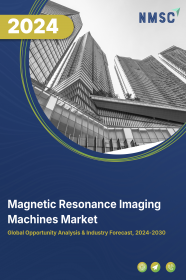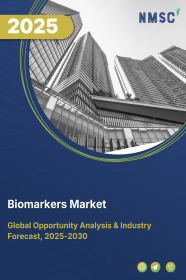
Magnetic Resonance Imaging Machines Market by Type (Closed MRI Systems, Open MRI Systems, and Portable MRI Systems), by Field Strength (Low-Field MRI, High-Field MRI, and Ultra-High-Field MRI), by Application (Neurology, Musculoskeletal, Cardiovascular, Oncology, Paediatrics, and Others), and by End User (Healthcare and Research Institutes) – Global Opportunity Analysis and Industry Forecast – 2024 – 2030
US Tariff Impact on Magnetic Resonance Imaging Machines Market
Trump Tariffs Are Reshaping Global Business
Magnetic Resonance Imaging Machines Market Overview
The global Magnetic Resonance Imaging Machines Market size was valued USD 6.31 billion in 2023, and it is projected to reach USD 9.16 billion by 2030 with a CAGR of 5.5% from 2024–2030. The magnetic resonance imaging (MRI) machines include devices that utilize magnetic fields and radio waves to create detailed images of the body’s internal structures that helps to diagnose various medical conditions.
The MRI machines work by aligning the body's hydrogen atoms using a strong magnetic field, then sending radio waves to disturb this alignment, that releases energy to capture and transform into images by a computer.
These radiology diagnostic machines are used for non-invasive diagnostics in neurology, orthopaedics, cardiology, and oncology, offering clearer and more precise imaging of soft tissues than alternatives such as X-rays or CT scans.
The key benefits include its ability to detect abnormalities without radiation exposure and its superior contrast resolution, that enhances the visibility of internal organs, blood vessels, and tissues, making it a crucial tool in early disease detection.
Market Dynamics and Trends
The increasing prevalence of chronic diseases such as cancer, cardiovascular disorders, and neurological conditions fuels the magnetic resonance imaging machines market growth due to the heightened need for accurate and non-invasive diagnostic imaging. The rising demand for early and precise diagnosis drives healthcare providers to increasingly rely on MRI machines for detailed imaging of soft tissues and internal structures.
According to the latest report published by the World Health Organization (WHO), there’s an estimated 20 million new cancer cases recorded in 2022 and this figure is projected to reach 35 million 2050, marking a growth of 75% in the span of 28 years. This surge of chronic diseases necessitates the need for advanced MRI technologies to enhance diagnostic capabilities and improve patient outcomes that ultimately propels the market growth.
Moreover, the rising healthcare expenditure further propels the growth of the market as it enables healthcare facilities to invest in advanced imaging technologies and expand their diagnostic capabilities. The increased funding allows hospitals and clinics to upgrade existing MRI systems and acquire new machines, improving the quality and availability of diagnostic services.
As per the latest report published by the World Bank Group, the healthcare expenditure per capita accounted for USD 1265 in 2021 as compared to USD 1086 in 2018 that is a growth of 16.5% in the period of 3 years. The focus on enhancing healthcare infrastructure and patient care drives demand for advance MRI equipment that in turn contributes to the magnetic resonance imaging machines market expansion.
Furthermore, the government initiatives in the healthcare sector further fuels the market growth by increasing funding and support for the development of healthcare infrastructure. These initiatives include grants, subsidies, and incentives aimed at upgrading medical facilities and expanding access to advanced diagnostic technologies. The emphasis on improving healthcare quality and accessibility drives investments in MRI machines, enabling healthcare providers to adopt the latest equipment.
For instance, in March 2024, the Advanced Research Projects Agency for Health (ARPA-H) collaborated with Center for Devices and Radiological Health (CDRH) to enhance access the high-quality medical imaging data.
Additionally, in August 2023, Union Ministry of India collaborated with Voxelgrids Innovations Pvt. Ltd. to launch MRI Scanner that reduced the cost of MRI scans, making them more accessible to the general public and decreasing reliance on expensive imported machines. These initiatives by government bodies leads to greater adoption of MRI technologies, thereby supporting the technological advancements, and contributing to the overall expansion of the market.
However, the high initial investment cost for manufacturing of MRI machines hinders the overall growth of the market. On the contrary, the integration of PET/MRI ultrasound creates significant future growth opportunities in the market as it enhances diagnostic accuracy and expands the range of clinical applications.
The combination of PET with MRI offers superior medical imaging capabilities by providing both metabolic and structural information that is crucial for early detection and precise treatment planning in complex conditions such as cancer and neurological disorders.
Market Segmentations and Scope of the Study
The magnetic resonance imaging machines market report is divided on the basis of type, field strength, application, end user, and region. On the basis of type, the market is divided into closed MRI systems, open MRI systems, and portable MRI systems. On the basis of field strength, the market is segmented into low-field MRI, high-field MRI, and ultra-high-field MRI. On the basis of application, the market is classified into neurology, musculoskeletal, cardiovascular, oncology, paediatrics, and others. On the basis of end user, the market is bifurcated into healthcare and research institutes. Regional breakdown and analysis of each of the aforesaid segments includes regions comprising of North America, Europe, Asia-Pacific, and RoW.
Geographical Analysis
North America dominates the magnetic resonance imaging machines market share at present and is projected to continue its dominance throughout the forecast period. The rapid healthcare expenditure in the region drives significant investments in advanced medical technologies including MRI machines.
The focus on improving healthcare infrastructure and patient care supports the adoption of advance MRI systems. As per the latest report published by the World bank Group, the region’s healthcare expenditure accounted for USD 11,818 in 2021 compared to USD 10,088 in 2019, a growth of 17.1% in the span of 2 years. The increased funding allows healthcare facilities to upgrade their imaging equipment and expand diagnostic capabilities that contributes to the expansion of the market.
Moreover, the presence of key players such as FUJIFILM Holdings America Corporation, Fonar Corporation, and others further fuels the growth of the industry in the region as it drives innovation and enhances market competitiveness.
The involvement of leading companies brings advanced MRI technologies, research and development capabilities, and comprehensive service offerings to the market. These companies introduce advance MRI systems with improved imaging capabilities, enhanced patient comfort, and greater diagnostic precision.
For instance, in August 2023, FUJIFILM Holdings America Corporation launched the ECHELON Synergy, a new 1.5 Tesla MRI system that utilizes AI to enhance image sharpness and accelerate scan times. The competition among major players accelerates technological advancements and helps to meet the growing demand for high-quality imaging solutions, thereby propelling the industry expansion in the region.
On the other hand, Asia-Pacific is considered the fastest-growing region in the magnetic resonance imaging machines market. This is due to the increasing prevalence of diseases such as cancer and neurological conditions in the region that drives the demand for advanced diagnostic imaging solutions.
According to the latest report published by the National Institute of Cancer Prevention and Research, one Indian woman dies of cervical cancer every 8 minutes in 2024. The rising prevalence of these diseases necessitates the use of MRI machines for accurate and early diagnosis, leading to greater adoption of MRI technologies in healthcare facilities that ultimately accelerates the market expansion.
Furthermore, the growing aging population further fuels the growth of the magnetic resonance imaging machines market trends in the region due to the increased prevalence of age-related health conditions that require advanced diagnostic imaging.
The rise in chronic diseases and conditions such as musculoskeletal issues and cardiovascular diseases among the elderly population necessitates the demand for MRI scans.
As per the latest report published by the Economic and Social Commission for Asia and the Pacific (ESCAP), the number of older persons in the region accounted for 630 million 2020 and it is projected to reach 1.3 billion by 2050, resulting a growth of 106% within the period of 30 years. The need for accurate and timely imaging to manage and monitor these conditions accelerates the adoption of MRI machines in healthcare facilities that further propels the market growth.
Competitive Landscape
The magnetic resonance imaging machines industry comprises of various market players that includes Aspect Imaging, Fonar Corporation, Hitachi High-Tech Corporation, Koninklijke Philips NV, GE Healthcare, Siemens Healthcare GmbH, Neusoft Medical Systems Co. Ltd, Esaote SpA, Canon Medical Systems Corporation, Aurora Healthcare Us Corp, and others. These companies are adopting strategies including collaborations to maintain their dominance in the sector.
For instance, in July 2024, Koninklijke Philips NV India partnered with Star Imaging to launch the first-of-its-kind MRI Training School in India that aims to provide international standard training on MRI technologies across 17 sub-specialties.
Moreover, in November 2023, Fonar Corporation collaborated with the AIRS Medical to improve MRI image quality and reduce scan times by up to 50% through AI-driven denoising and sharpening.
Key Benefits
-
The report provides quantitative analysis and estimations of the magnetic resonance imaging machines market from 2024 to 2030, which assists in identifying the prevailing industry opportunities.
-
The study comprises a deep-dive analysis of the current and future magnetic resonance imaging machines market trends to depict prevalent investment pockets in the industry.
-
Information related to key drivers, restraints, and opportunities and their impact on the market is provided in the report.
-
Competitive analysis of the key players, along with their market share is provided in the report.
-
SWOT analysis and Porters Five Forces model is elaborated in the study.
-
Value chain analysis in the market study provides a clear picture of roles of stakeholders
Magnetic Resonance Imaging Machines Market Key Segments
By Type
-
Closed MRI Systems
-
Open MRI Systems
-
Portable MRI Systems
By Field Strength
-
Low-Field MRI
-
High-Field MRI
-
Ultra-High-Field MRI
By Application
-
Neurology
-
Musculoskeletal
-
Cardiovascular
-
Oncology
-
Paediatrics
-
Others
By End User
-
Healthcare
-
Research Institutes
By Region
-
North America
-
The U.S.
-
Canada
-
Mexico
-
-
Europe
-
The UK
-
Germany
-
France
-
Italy
-
Spain
-
Denmark
-
Netherlands
-
Finland
-
Sweden
-
Norway
-
Russia
-
Rest of Europe
-
-
Asia-Pacific
-
China
-
Japan
-
India
-
South Korea
-
Australia
-
Indonesia
-
Singapore
-
Taiwan
-
Thailand
-
Rest of Asia Pacific
-
-
RoW
-
Latin America
-
Middle East
-
Africa
-
Key Players
-
Aspect Imaging
-
Fonar Corporation
-
Hitachi High-Tech Corporation
-
Koninklijke Philips NV
-
GE Healthcare
-
Siemens Healthcare GmbH
-
Neusoft Medical Systems Co. Ltd.
-
Esaote SpA
-
Canon Medical Systems Corporation
-
Aurora Healthcare Us Corp
REPORT SCOPE AND SEGMENTATION:
|
Parameters |
Details |
|
Market Size in 2023 |
USD 6.31 Billion |
|
Revenue Forecast in 2030 |
USD 9.16 Billion |
|
Growth Rate |
CAGR of 5.5% from 2023 to 2030 |
|
Analysis Period |
2023–2030 |
|
Base Year Considered |
2023 |
|
Forecast Period |
2024–2030 |
|
Market Size Estimation |
Billion (USD) |
|
Growth Factors |
|
|
Countries Covered |
28 |
|
Companies Profiled |
10 |
|
Market Share |
Available for 10 companies |
|
Customization Scope |
Free customization (equivalent up to 80 working hours of analysts) after purchase. Addition or alteration to country, regional, and segment scope. |
|
Pricing and Purchase Options |
Avail customized purchase options to meet your exact research needs. |

















 Speak to Our Analyst
Speak to Our Analyst




















